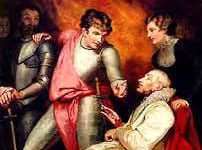Religious Tensions in the 16th Century
Religious Tensions in the 16th Century
Religious Tensions in the 16th Century
Introduction
The 16th century was a turbulent period marked by profound religious tensions across Europe. The Reformation, ignited by Martin Luther’s criticism of the Catholic Church, led to significant religious and social upheavals, shaping the course of history and influencing the development of different religious traditions.
The Reformation
Martin Luther and the Ninety-Five Theses
The spark that ignited the Reformation occurred in 1517 when Martin Luther, a German monk, challenged the practices of the Catholic Church by posting his Ninety-Five Theses on the door of the Wittenberg Castle Church. Luther’s grievances centered on issues such as the sale of indulgences and the authority of the Pope.
Spread of Protestantism
Luther’s ideas gained momentum, leading to the establishment of Protestantism. Other reformers, such as John Calvin and Ulrich Zwingli, contributed to the spread of Protestant doctrines. The movement challenged the authority of the Catholic Church and advocated for a more direct relationship between individuals and God.
Catholic Counter-Reformation
Council of Trent
In response to the Reformation, the Catholic Church initiated the Counter-Reformation, aiming to address internal corruption and doctrinal issues. The Council of Trent (1545–1563) played a crucial role in defining Catholic doctrine and addressing the challenges posed by Protestantism.
Jesuit Order
The Society of Jesus, or the Jesuits, founded by Ignatius of Loyola, became a prominent force in the Counter-Reformation. The Jesuits were instrumental in promoting Catholic education, missionary work, and combatting the spread of Protestantism.
Wars of Religion
French Wars of Religion
France experienced religious tensions during the French Wars of Religion (1562–1598). The conflict between Catholics and Huguenots (French Calvinists) resulted in a series of wars and intermittent periods of peace, culminating in the Edict of Nantes in 1598.
Thirty Years’ War
The Thirty Years’ War (1618–1648) engulfed Central Europe in a complex web of religious and political conflicts. Initially sparked by the tensions between Catholics and Protestants, the war evolved into a broader struggle for political power involving various European nations.
Persecution and Intolerance
Witch Hunts and Religious Persecution
The 16th century witnessed a surge in witch hunts, often fueled by religious tensions. The fear of witchcraft and the association of alleged witches with heresy led to widespread persecution and executions across Europe.
Religious Intolerance
Religious intolerance manifested in various forms, with governments and rulers imposing religious conformity. The Peace of Augsburg in 1555, for example, allowed German states to choose between Catholicism and Lutheranism but excluded other Protestant denominations.
Impact on Society and Culture
Cultural and Artistic Changes
Religious tensions influenced cultural and artistic expressions. Iconoclasm, the destruction of religious images, occurred in Protestant areas, while Catholic regions saw the flourishing of Baroque art as a response to the Counter-Reformation.
Education and Literacy
The Reformation contributed to increased emphasis on education and literacy. Protestant beliefs often encouraged the reading of Scriptures, leading to higher literacy rates in Protestant regions.
Impacts
Fragmentation of Christianity
The religious tensions of the 16th century contributed to the lasting fragmentation of Christianity. Protestantism and its various denominations emerged alongside Catholicism, shaping the religious map of Europe and influencing global Christianity.
Modern Perspectives on Religious Tensions
The religious tensions of the 16th century left a lasting impact on discussions surrounding religious freedom, tolerance, and the separation of church and state. These issues continue to shape contemporary debates on religious coexistence and diversity.
Conclusion
In conclusion, the 16th century was a period of intense religious tensions, fueled by the Reformation, the Counter-Reformation, and subsequent wars of religion. These conflicts reshaped the religious and cultural landscape of Europe, contributing to the emergence of distinct Protestant and Catholic traditions and influencing the trajectory of Christianity for centuries to come. 0 0 0.
Religious Tensions in the 16th Century, Religious Tensions in the 16th Century
N.B. The article ‘Religious Tensions in the 16th Century’ originally belongs to the book entitled ‘Essays on Shakespeare and His Time‘ by Menonim Menonimus.
You May Like:
- Reviews on Shakespeare’s Works
- Shakespeare’s Sister-An Analytical Study
Additional Searches:
- Shakespeare’s Legacy Shaping Modern Literature
- Religious Crisis in the 16th Century
- Christianity in the 16th Century …











